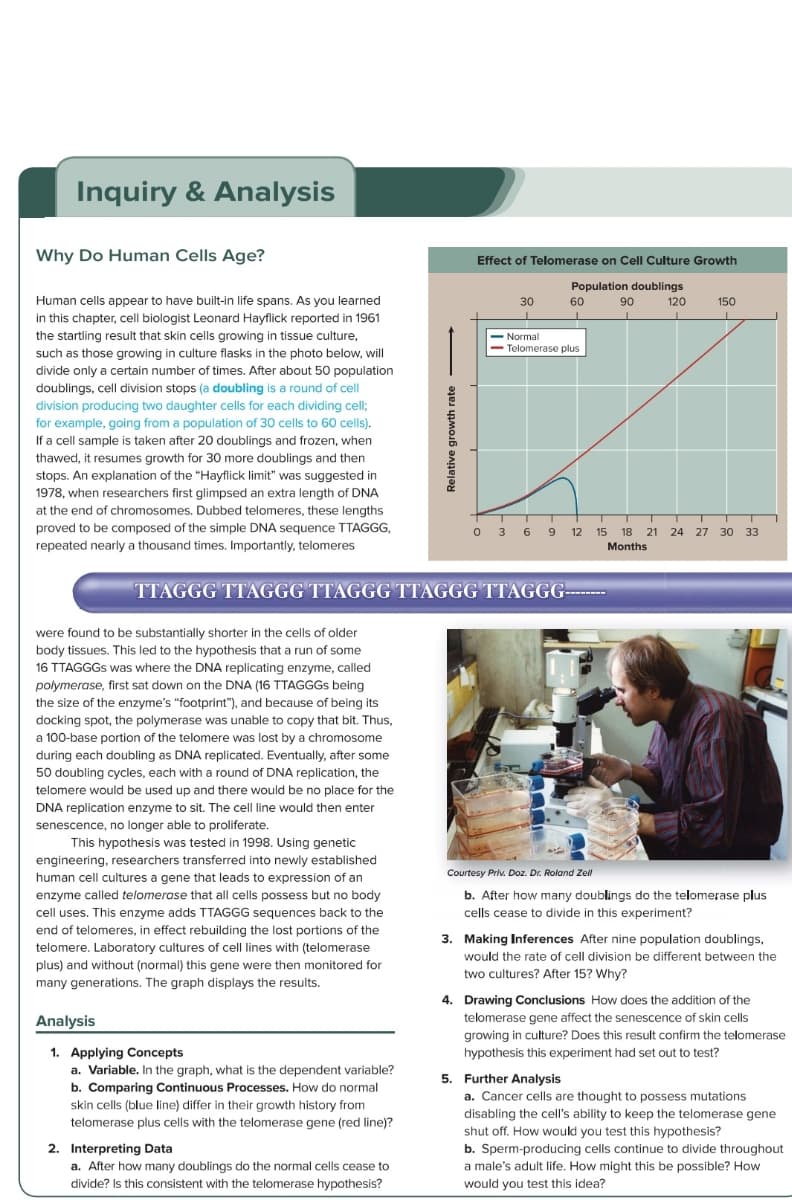1. Applying Concepts a. Variable. In the graph, what is the dependent variable? b. Comparing Continuous Processes. How do normal skin cells (blue line) differ in their growth history from telomerase plus cells with the telomerase gene (red line)?
1. Applying Concepts a. Variable. In the graph, what is the dependent variable? b. Comparing Continuous Processes. How do normal skin cells (blue line) differ in their growth history from telomerase plus cells with the telomerase gene (red line)?
Biology: The Dynamic Science (MindTap Course List)
4th Edition
ISBN:9781305389892
Author:Peter J. Russell, Paul E. Hertz, Beverly McMillan
Publisher:Peter J. Russell, Paul E. Hertz, Beverly McMillan
Chapter10: Cell Division And Mitosis
Section: Chapter Questions
Problem 1ITD: Biologists have long been interested in the effects of radiation on cells. In one experiment,...
Related questions
Question
Do Q1 Applying concepts both part a as well as b

Transcribed Image Text:Inquiry & Analysis
Why Do Human Cells Age?
Effect of Telomerase on Cell Culture Growth
Population doublings
Human cells appear to have built-in life spans. As you learned
30
60
90
120
150
in this chapter, cell biologist Leonard Hayflick reported in 1961
the startling result that skin cells growing in tissue culture,
such as those growing in culture flasks in the photo below, will
Normal
Telomerase plus
divide only a certain number of times. After about 50 population
doublings, cell division stops (a doubling is a round of cell
division producing two daughter cells for each dividing cell;
for example, going from a population of 30 cells to 60 cells).
If a cell sample is taken after 20 doublings and frozen, when
thawed, it resumes growth for 30 more doublings and then
stops. An explanation of the "Hayflick limit" was suggested in
1978, when researchers first glimpsed an extra length of DNA
at the end of chromosomes. Dubbed telomeres, these lengths
proved to be composed of the simple DNA sequence TTAGGG,
0 3 6 9 12 15 18 21 24 27
30 33
repeated nearly a thousand times. Importantly, telomeres
Months
TTAGGG TTAGGG TTAGGG TTAGGG TTAGGG---
were found to be substantially shorter in the cells of older
body tissues. This led to the hypothesis that a run of some
16 TTAGGGS was where the DNA replicating enzyme, called
polymerase, first sat down on the DNA (16 TTAGGGS being
the size of the enzyme's "footprint"), and because of being its
docking spot, the polymerase was unable to copy that bit. Thus,
a 100-base portion of the telomere was lost by a chromosome
during each doubling as DNA replicated. Eventually, after some
50 doubling cycles, each with a round of DNA replication, the
telomere would be used up and there would be no place for the
DNA replication enzyme to sit. The cell line would then enter
senescence, no longer able to proliferate.
This hypothesis was tested in 1998. Using genetic
engineering, researchers transferred into newly established
Courtesy Priv. Doz. Dr. Roland Zel
human cell cultures a gene that leads to expression of an
enzyme called telomerase that all cells possess but no body
b. After how many doublings do the telomerase plus
cell uses. This enzyme adds TTAGGG sequences back to the
cells cease to divide in this experiment?
end of telomeres, in effect rebuilding the lost portions of the
telomere. Laboratory cultures of cell lines with (telomerase
3. Making Inferences After nine population doublings,
would the rate of cell division be different between the
plus) and without (normal) this gene were then monitored for
two cultures? After 15? Why?
many generations. The graph displays the results.
4. Drawing Conclusions How does the addition of the
Analysis
telomerase gene affect the senescence of skin cells
growing in culture? Does this result confirm the telomerase
1. Applying Concepts
a. Variable. In the graph, what is the dependent variable?
b. Comparing Continuous Processes. How do normal
skin cells (blue line) differ in their growth history from
telomerase plus cells with the telomerase gene (red line)?
hypothesis this experiment had set out to test?
5. Further Analysis
a. Cancer cells are thought to possess mutations
disabling the cell's ability to keep the telomerase gene
shut off. How would you test this hypothesis?
2. Interpreting Data
a. After how many doublings do the normal cells cease to
divide? Is this consistent with the telomerase hypothesis?
b. Sperm-producing cells continue to divide throughout
a male's adult life. How might this be possible? How
would you test this idea?
Relative growth rate
Expert Solution
This question has been solved!
Explore an expertly crafted, step-by-step solution for a thorough understanding of key concepts.
This is a popular solution!
Trending now
This is a popular solution!
Step by step
Solved in 2 steps

Knowledge Booster
Learn more about
Need a deep-dive on the concept behind this application? Look no further. Learn more about this topic, biology and related others by exploring similar questions and additional content below.Recommended textbooks for you

Biology: The Dynamic Science (MindTap Course List)
Biology
ISBN:
9781305389892
Author:
Peter J. Russell, Paul E. Hertz, Beverly McMillan
Publisher:
Cengage Learning

Human Heredity: Principles and Issues (MindTap Co…
Biology
ISBN:
9781305251052
Author:
Michael Cummings
Publisher:
Cengage Learning

Biology (MindTap Course List)
Biology
ISBN:
9781337392938
Author:
Eldra Solomon, Charles Martin, Diana W. Martin, Linda R. Berg
Publisher:
Cengage Learning

Biology: The Dynamic Science (MindTap Course List)
Biology
ISBN:
9781305389892
Author:
Peter J. Russell, Paul E. Hertz, Beverly McMillan
Publisher:
Cengage Learning

Human Heredity: Principles and Issues (MindTap Co…
Biology
ISBN:
9781305251052
Author:
Michael Cummings
Publisher:
Cengage Learning

Biology (MindTap Course List)
Biology
ISBN:
9781337392938
Author:
Eldra Solomon, Charles Martin, Diana W. Martin, Linda R. Berg
Publisher:
Cengage Learning

Biology 2e
Biology
ISBN:
9781947172517
Author:
Matthew Douglas, Jung Choi, Mary Ann Clark
Publisher:
OpenStax